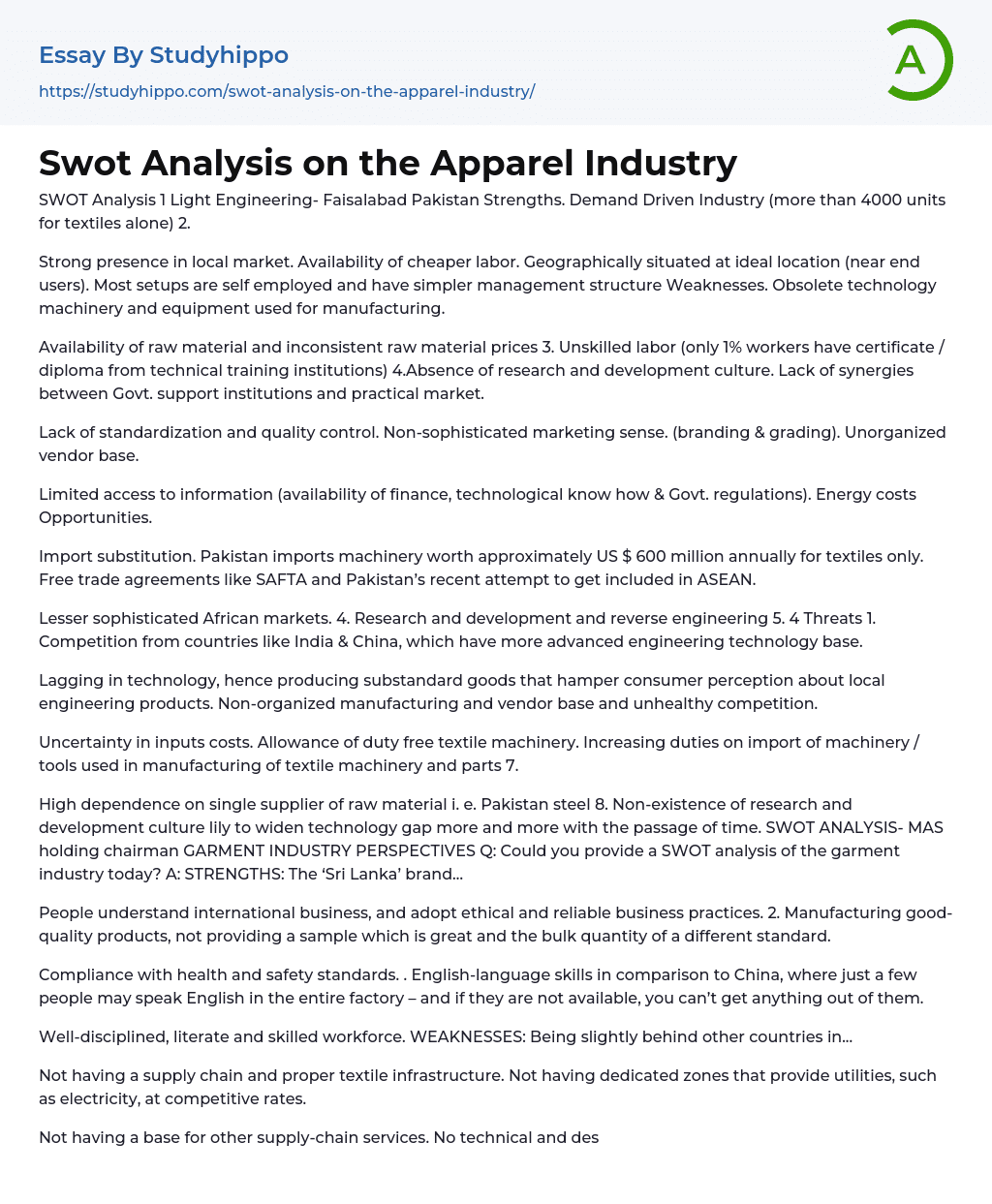SWOT Analysis
- Light Engineering- Faisalabad Pakistan Strengths. Demand Driven Industry (more than 4000 units for textiles alone)
- Strong presence in local market. Availability of cheaper labor. Geographically situated at ideal location (near end users). Most setups are self employed and have simpler management structure Weaknesses. Obsolete technology machinery and equipment used for manufacturing. Availability of raw material and inconsistent raw material prices
- Unskilled labor (only 1% workers have certificate / diploma from technical training institutions)
- Absence of research and development culture. Lack of synergies between Govt. support institutions and practical market.
Lack of standardization and quality control. Non-sophisticated marketing sense. (branding & grading). Unorganized vendor base.
Limited access to information (availability of finance, technological know how & Govt. regulations). Energy costs Opportunities.
Import substitution. Pakistan imports machinery worth approximately US $ 600 million annually for textiles
...only. Free trade agreements like SAFTA and Pakistan’s recent attempt to get included in ASEAN.
Lesser sophisticated African markets.
Research and development and reverse engineering 5. 4
Threats
- Competition from countries like India & China, which have more advanced engineering technology base.
- Lagging in technology, hence producing substandard goods that hamper consumer perception about local engineering products. Non-organized manufacturing and vendor base and unhealthy competition.
- Uncertainty in inputs costs. Allowance of duty free textile machinery. Increasing duties on import of machinery / tools used in manufacturing of textile machinery and parts
- High dependence on single supplier of raw material i. e. Pakistan steel
- Non-existence of research and development culture lily to widen technology gap more and more with the passage of time.
SWOT ANALYSIS- MAS holding chairman GARMENT INDUSTRY PERSPECTIVES
Q: Could you provide a SWOT analysis of the garment industry today?
A: STRENGTHS: The ‘Sri Lanka’ brand…
WEAKNESSES:
- Being slightly behind other countries in...
- Not having a supply chain and proper textile infrastructure. Not having dedicated zones that provide utilities, such as electricity, at competitive rates.
- Not having a base for other supply-chain services. No technical and design skills.
- No proper merchandising skills.
OPPORTUNITIES:With pressure on China, lots of buyers, retailers and brands are looking for alternatives to China. Sri Lanka has a tremendous opportunity to position itself as an outstanding alternative in active wear, children’s wear, casual wear and intimate apparel.
THREATS: We have to be careful about being competitive internationally – not only in comparison to countries such as India, Vietnam and Indonesia.
I believe there is another way of looking at this:
- we can’t view ourselves in isolation.
- We have to look at ourselves in relation to the rest of South Asia and see how we can leverage on each other’s strengths to perform well as a region.
If we attempt to play in the huge global arena by ourselves, it will be a daunting challenge. Janaka Boteju – Sri Lanka Apparel exporters association Sri Lanka
Apparel Industry Strengths
Reputation of being a quality apparel manufacturer for the mass market.
Compliance with International Labour regulations. Relatively disciplined and skilled labour and a trainable work
force.
Reputed International Customer base.
On-time delivery of standard “all- season” products. Weaknesses Isolation from trade partners and heavy dependence on local buying agencies.
Lack of geographical diversification in terms of its overseas markets. In-sufficient international and bi-lateral trade agreements to support the industry. Increasing cost of labour compared with other countries in the south Asian region
Inadequate focus on developing backward integration linkages to support the industry. Non-existence of product design and new product developments. 7. Non-existence of a Sri Lankan brand identity.
Low productivity of labour, inefficient use of machinery and manufacturing processes. The relatively high cost of utilities.
Opportunities
- Sri Lanka to become a total service provider for the global apparel industry.
- Promote Sri Lanka as a socially responible manufacturer of apparels.
- Transition to products that require a high labour content. The positive impact of the government’s peace initiative
Threats 1.
Rapidly changing trends in the retailing industry. The former socialist countries and the East European nation are potential to become major suppliers for the EU Market.
Global formation of bi-lateral and multi-lateral trade blocks. New entrants to the industry. Emergence of efficient international shipping hubs in the Asian region.
- Factory essays
- Material essays
- Production And Manufacturing essays
- Alarm clock essays
- Career essays
- Career Path essays
- Homeless essays
- Labour Economics essays
- Occupational Safety And Health essays
- Pension essays
- Profession essays
- Salary essays
- Strike Action essays
- Wage essays
- Working Together essays
- Workplace essays
- Accounting essays
- Andrew Carnegie essays
- Automation essays
- Business Cycle essays
- Business Intelligence essays
- Business Model essays
- Business Operations essays
- Business Software essays
- Cooperation essays
- Cooperative essays
- Corporate Social Responsibility essays
- Corporation essays
- Customer Relationship Management essays
- Family Business essays
- Franchising essays
- Harvard Business School essays
- Harvard university essays
- Human Resource Management essays
- Infrastructure essays
- Inventory essays
- Logistics essays
- Management essays
- Manufacturing essays
- Market essays
- Marketing essays
- Multinational Corporation essays
- News Media essays
- Online Shopping essays
- Quality Assurance essays
- Richard Branson essays
- Sales essays
- Selling essays
- Shopping Mall essays
- Small Business essays




